ኢትዮጵያ

Ethiopia
Empire

Ethiopia
Peoples democratic republic

Ethiopia
Federal democratic republic
Quick reference
General issues: Ministerial concession 1894-1908, Empire 1908-1936, Empire 1942-1974, Provisional government 1974-1987, Peoples democratic republic 1987-1991, Transitional government 1991-1995, Federal democratic republic 1995-Present
Country name on general issues: Ethiopia in Amharic ኢትዮጵያ, Postes Ethiopiennes, Ethiopie, Ethiopia
Special issues: Foreign offices France 1906, Local issues Dire Dawa 1911
Currency: 1 Thaler = 16 Guerche 1894-1904, 1 Franc = 100 Centimes 1904-1907, 1 Thaler = 16 Piastres 1908-1928, 1 Thaler = 16 Mehaleks 1928-1936, 1 Talar = 100 Centimes 1942-1946, 1 Dollar = 100 Cents 1946-1976, 1 Birr = 100 Cents 1976-Present
Population: 11 901 000 in 1900, 94 100 000 in 2013
Political history Ethiopia
Setting the scene
Ethiopia is located in eastern Africa. The population consists of Afro-Asiatic peoples of which Oromo and Amhara are the largest groups, and although the Amhara are the second largest group, Amharic is the official language of Ethiopia. Several of the smaller population groups also live in neighboring countries – the Afars that are the largest population group in Djibouti, the Tigray also living in Eritrea and the Somali that also live in Somalia. Ethiopia has a long history. The last imperial dynasty traced its roots to 950 BC. In the 4th century Ethiopia was the first nation to adopt Christianity. Muslim influences are recorded as early as the 7th century. Contacts with Europe are established from the 15th century.
The Ethiopian Empire in the late 19th and early 20th centuries
The modern history of Ethiopia begins in the mid 19th century. Having fallen apart in the mid 18th century, Ethiopia is once again unified under imperial rule and in the last part of the 19th and early part of the 20th century the power of warlords controlling parts of the country is ended. Smaller border states are incorporated in the Ethiopian empire, and Ethiopia is modernized using European advisers. At the height of the colonial ‘Scramble for Africa’, Ethiopia is one of the two countries on the African continent to retain its independence. In 1875-1876, the Egyptians – then under Ottoman sovereignty – are defeated. In 1889, Italian advances force Ethiopia to acknowledge Italian sovereignty over Eritrea. Italian ambitions of colonizing Ethiopia are thwarted when, in 1896, Italy is defeated in the battle of Adowa. The borders of Ethiopia are defined through treaties in the late 19th and early 20th centuries. In 1916, Haile Selassi ascends to power in Ethiopia, first as regent and from 1930 as emperor – to become one of the longest reigning monarchs in history.
Italian and British rule
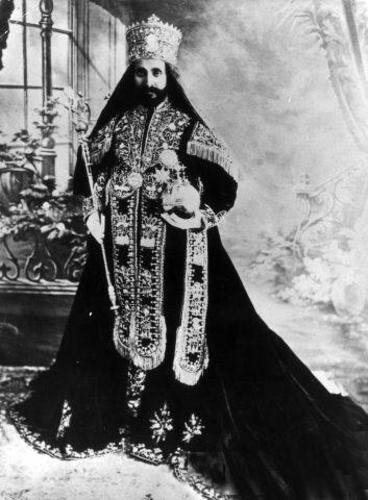
Emperor Heile Selassie in full imperial dress at the occasion of his coronation in 1930.
In 1935, the imperial ambitions of fascist Italy under Mussolini lead to an Italian invasion of Ethiopia from neighboring Italian Eritrea and Italian Somaliland. Italy now comes out victorious and in 1936 annexes Ethiopia as an Italian colony which, still in 1936, is made part of Italian East Africa, together with Italian Eritrea and Italian Somaliland.
Italian rule will, however, not last long. Shortly after the outbreak of WWII, the British, in 1940, embark on the East Africa Campaign and by 1941 the Italian administration of Italian East Africa capitulates – although isolated Italian forces will fight a guerrilla war until 1943. The British, in 1941, establish military administration in the former Italian possessions. In Ethiopia the British, in 1942, recognize Ethiopian sovereignty. Although the British retain certain prerogatives, Heile Selassie is restored to the throne and military administration is ended. Full sovereignty over most of the country is gained by Ethiopia in 1944. The Ogaden region, the Haud region and the so called Reserved Areas – areas on the border with French Somaliland – are regions with a primarily Somali population and will remain under British administration. The British propose a larger Somali state to be formed from British and Italian Somaliland and the Somali regions in Ethiopia. Eventually, events will turn out in such a way that the Ogaden region is returned to Ethiopia in 1948. The Haud region and the Reserved Areas are returned in 1954. The Somali region of Ethiopia will, however, be claimed by Somalia upon gaining independence in 1960 and lead to the Ethiopian-Somali war of 1977-1978 – a war that ends in the status quo ante bellum. The border between Ethiopia and Somalia is, until the present day, a provisional one.
Eritrea
Events in the Horn of Africa also lead to Eritrea – an Italian possession since 1889 and under British administration since WWII – to be federated with Ethiopia in 1952. Eritrea is fully annexed by Ethiopia in 1962 – an annexation that will signal the start of armed opposition to Ethiopian rule. The war of independence will last three decades – in 1991 Eritrea gains de facto independence, independence is de jure recognized in 1993. Relations with Eritrea have since been tense – escalating in a border war between 1998 and 2000. The border is still disputed.
Downfall of the empire and establishment of the republic
In 1974, increasing protests against the rule of Heile Selassie culminate in a coup d’etat. A Provisional Military Administrative Council, led by Mengistu, is established – Heile Selassie is officially deposed in 1975. Ethiopia is turned into a socialist style one party state aligned with the communist world. In 1987, Ethiopia officially becomes the peoples democratic republic of Ethiopia. Opposing forces fight the Mengistu regime from 1974. As these opposition forces join ranks and the support from the Soviet Union ends after the break up of the Soviet Union, the Mengistu regime is brought down in 1991. A transitional government prepares a new constitution in 1994, allowing for the first ever free elections in Ethiopia to be held in 1995. Also, in 1995, Ethiopia is made a federal republic – officially the federal democratic republic of Ethiopia. The federal character is related to regions that are defined based on the ethnic majorities. On the national level, the coalition that came to power in 1991 has remained in power until the present day.
The Ethiopian economy is based on agriculture, coffee being the main export product. In the 1980’s, Ethiopia has suffered from droughts, not only affecting the economy but leading to large scale famines. Although the Ethiopian economy has shown significant growth in recent years, Ethiopia is a still very much a developing country – in terms of per capita GDP Ethiopia ranks 217 out of 230 countries in the world.
Postal history Ethiopia
Foreign offices
The first post office to be opened in Ethiopia was an Egyptian office opened in Harar in 1866 – using Egyptian stamps, the office was in operation until 1880. The French opened offices in Addis Ababa, Dire Dawa and Harar in 1892. The stamps initially used were the stamps of Obock and its successor the French Somali Coast. In 1906, stamps were issued for specific use in the Ethiopian offices – stamps of France inscribed ‘Levant’. This issue was used only for a short time – in 1907 the offices in Ethiopia went back to the use of stamps from the French Somali Coast. International mail from Ethiopia was routed primarily through these French offices until 1908, when Ethiopia joined the UPU. The French offices closed in 1908. British consular offices have existed in Adis Ababa and Harar – resources used do not indicate when these were first opened. In the British offices the stamps of British Somaliland and later British India were used.
From a ministerial concession to imperial post
The first Ethiopian postal service is set up from 1894 by Alfred Ilg – a Swiss adviser to the imperial court who had risen to the level of minister. Alfred Ilg was granted a number of concessions, one of them being to set up a postal service. The first stamps were issued in 1894 – in part showing a portrait of the emperor and in part the lion of Judah – one of the titles of the emperor. As it was discovered that these stamps were sold below face value for postal use, the stamps were reissued in subsequent years with a number of different control overprints.
In 1908, Ethiopia joined the UPU and the postal services were, from then, run by the government. In the four decades until the Italian annexation, Ethiopia has issued only a relatively small number of definitives – stamps of exclusive designs printed mostly in Paris. The small number of definitives is compensated by a large number of overprints issued for a variety of reasons. A local issue appeared at Dire Dawa due to a shortage of stamps. Available stamps from the 1894 issue were overprinted using hand stamps and were given a new denomination in hand writing.
Italian and British administration
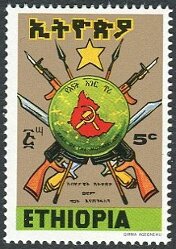
1977 – Arms and a shield with the map of Ethiopia showing the hammer and sickle of the socialist revolution.
After Italian annexation in 1936 one set has been issued in 1936 specifically for Italian Ethiopia – otherwise the stamps of Italian Eritrea and Italian Somaliland came to be used widely in Ethiopia from 1936. All these were superseded by the issues for Italian East Africa from 1938.
Under British administration, British stamps are used from 1941 until in 1942 when Ethiopia resumes issuing stamps. Resources used do not indicate what stamps were used in the regions administered by the British after 1942 – the Ogaden and Haud regions. As these regions have been administered as part of the British administration of Italian Somaliland, one would suppose that the same stamps were used as in Italian Somaliland – thus, the issues of the Middle East Forces and later the issues of the East African Forces.
Overprints exist on postage stamps and revenues of Italian East Africa – the overprint reading ‘British occupation’ and a new face value. These were prepared but withdrawn before being issued. The Michel catalog has a listing for these issues.
Modern Ethiopia
Since Ethiopia has regained its independence in 1942, Ethiopia has issued stamps with designs mainly of national interest – both in the imperial period and after the establishment of the republic in 1974.
Album pages
← Previous page: EritreaNext page: Fernando Poo →

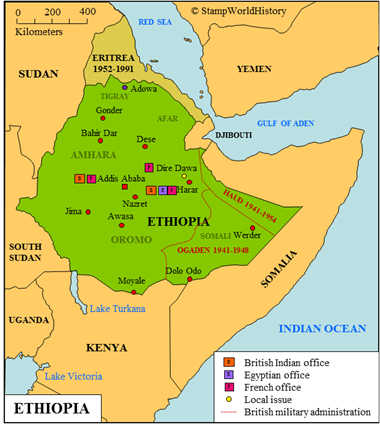
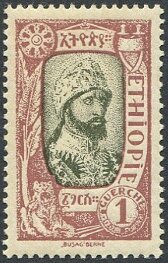
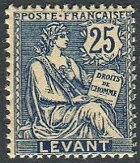
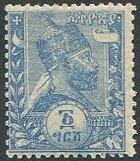



I WANT TO NOW ABOUT ETHIOPIAN ETHIOPIAN COVERS LIST
SINCE 1913 – 1923 IF YOU GET INFORMATION ABOUT
PLEASE SEND ME
MAMUSHA G.TSADIK
Hi Mamusha
I have no specialized knowledge about Ethiopia. Maybe this thread on the stamp collectors forum Stampboards.com is of use for you: Looking for Ethiopia catalogues.